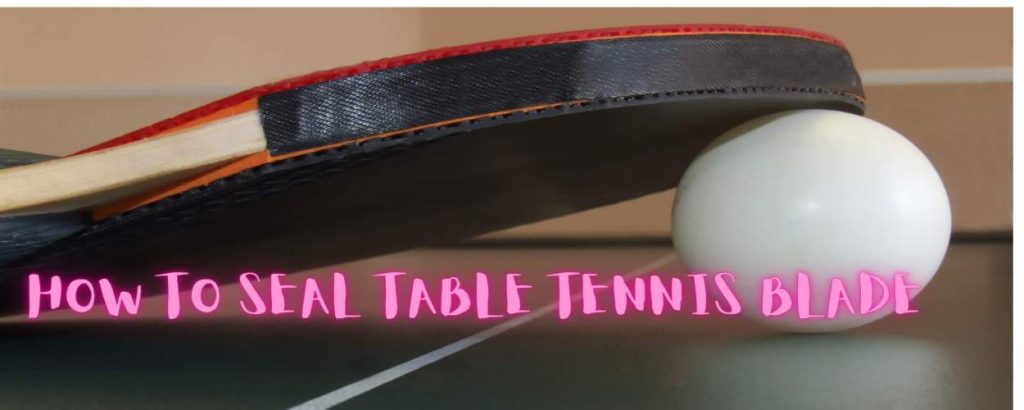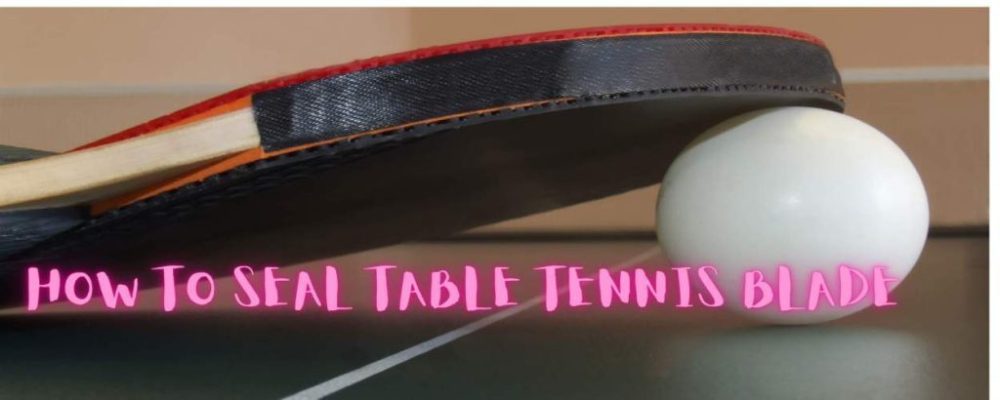To ensure the surface of your table tennis blade remains in pristine condition for its entire lifetime, I will outline some tips for how to seal the table tennis blade. There is nothing better than holding a brand new table tennis blade right out of the box. Keeping your blade clean and smooth for as long as possible is a thing of beauty, isn’t it? The sealing of the table tennis blade is very important if you want to increase the life of your blade.

Why Do You Want To Seal Your Table Tennis Blade
How does sealing your ping-pong blade benefit you? Do you think it’s worth it since it is a messy and tedious process?
There’s no need to worry. The danger of pulling wood splinters from the surface of your blade if it is not sealed is quite high. As rubbers are usually changed every three to six months, if your blade is not sealed, you will have a playing surface that looks like someone gouged it with a nail file.
Please keep in mind that glue sheets don’t protect players from getting wood splinters on their playing surfaces. A glue sheet brought tears to my eyes when I used it on an unsealed paddle, I should have known better, but I thought I could get away with it.
How To Seal Your Table Tennis Blade
- Sealing blades can be accomplished with either sanding sealer or polyurethane. In any hardware store, you can easily find both products. The use of hairspray has been mentioned by some players, but I don’t recommend it myself since it has to be reapplied every so often.
- The fumes from sealing can be quite noxious if done in an enclosed space. Don’t forget to ventilate.
- If you have sealed over dirt with an adhesive, you don’t want lumps on the surface. Make sure the blade surface is nice and clean.
- Make sure the blade is completely covered with sealer or polyurethane. Sandpaper can always be used to remove any excess.
- If you hold the blade at an angle to the light, you can see the light reflecting off the liquid on the blade to determine the sealer’s coverage. You can easily see if you missed anything.
- Be sure to seal the edges of the blade, but don’t bother sealing the handle, otherwise, it might become slippery when playing.
- After the polyurethane cures, you might need to lightly sandpaper the surface to make it rough enough for the rubber to stick to the blade. You may slip and peel your rubbers off in an accident if it is too slippery. As a result of sanding sealer sinking into the wood grain, it doesn’t really need to be sandpapered.
- After spreading the sealer, make sure the blade is securely held in place so it does not fall over.
- Take your time. Make sure you take extra care now to get the job done right since you will probably use this blade for a long time.
Always Seal The Blade From The Handle To The Head Of Blade. Never Seal The Bade From Left To Right Or Vice Versa.
The Benefits of Sealing Your Table Tennis Blade
Here we will discuss the benefits of sealing the blade
Protects the blade
It’s impossible to avoid blade damage over time, even when you’re extremely careful. Most of the damage to your blade will occur along its edge as a result of impacts from the table and your body.
The damaged edges become vulnerable to splintering as a result of this damage. Eventually, these splinters lift when it’s time to replace your rubbers and further damage your blade. Rubber removal is made easier by blade sealing in table tennis. As a result, chips of wood are less likely to be pulled away when they are removed.
Splinters are more likely to come off if you regularly change your rubbers. As a result, varnishing is a practice you should definitely take into consideration if you frequently switch them out, perhaps every three to six months.
Less Excess Glue
Generally, when you remove your rubbers, you will not find excess glue due to the diminished bond between the rubber and blade through blade sealing. It can sometimes be difficult to clean unvarnished blades of excess glue, so this is handy. The first thing I do after applying a new coat is clean my blade completely from old glue. In order to remove the excess, I often use my finger to rub it off, which is rather inconvenient.
Reduced Water Absorption
Water absorption is a lesser-known issue in table tennis. Some people believe blades need protection against water because wood doesn’t react well to it by nature. It is not an issue. The purpose of water-based table tennis glue is to glue rubber to blades, so it would be counter-intuitive if it caused damage to the blades.
Water-based ping pong glue doesn’t cause wood to deteriorate over time, because it takes a lot of constant exposure to water. Because of this, I think it’s fair to say that varnish is probably not necessary. Even so, the varnish will certainly prevent water-based table tennis glue from penetrating deeper into your blade’s layers if you are still concerned about water exposure.
The drawbacks of sealing your table tennis blade
Generally, varnishing table tennis blades has only two disadvantages. In addition, it’s not free; however, it’s so inexpensive that you might as well consider it free. Having your table tennis supplier apply varnish for you only costs a couple of dollars.
Varnish weakens the bond between rubber and blade, which is one of the main disadvantages of using it. As a result, you might have problems with your glue holding, or air bubbles may occur in areas where some parts have been glued well while others have not.
These pesky bubbles have been experienced by me personally. In the beginning, I had no problems with the varnish I purchased from the supplier. Soon after playing with my fresh rubbers, I noticed an air bubble when it was time to change them.
I assumed the glue would be the problem since the last rubbers had held fine. Despite switching glue, the rubbers failed to stay in place! It took me even hours to apply mountains of glue before entering a table tennis competition in hopes that it would hold. One of my rubbers literally flailed in the wind during the final because the glue failed. It was not a pleasant experience!
The varnish was the cause of the problem, I realized soon after. My problem was solved after I sanded it off. Because of this, it’s important to use a light coat of varnish if you do decide to varnish your blade.
Final thoughts
You can prolong the life of your table tennis blade by sealing it. Since many blades are costly, we should take all measures to prolong their life.
You can also varnish your blade yourself at a low cost if you don’t have your supplier do it for you. The varnish can always be sanded away if you make a mistake, but I suspect most of you will have no problem.

